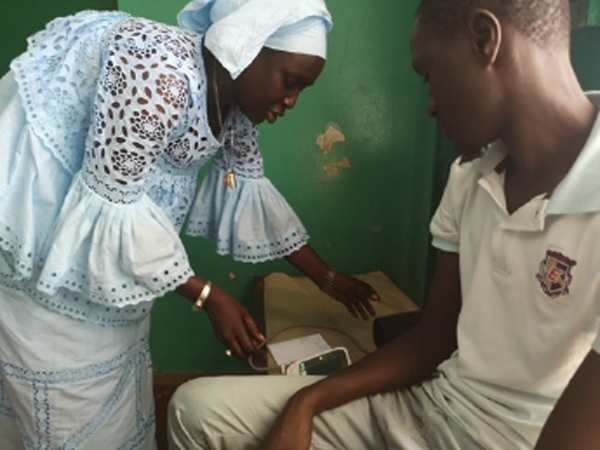The paradox of cardiovascular disease: Out in the open, but unaddressed

When prompted with the question, ’What is the world’s deadliest disease?’, what would be your first guess?
After having gone through the life-altering experience of a global pandemic in the past years, most of us may be likely to assume that infectious diseases are the biggest threat to our health. And, while this reaction is understandable, it’s incorrect. Cardiovascular disease (CVD) poses a far greater risk to our lives.
Globally, CVD accounts for a third of all deaths.1 That is almost 18 million people per year; 350,000 per week; and 50,000 every single day. The vast majority of deaths occur in low- and middle-income settings and claim lives prematurely, i.e., before the age of 60. The saddening pinnacle of this devastating statistic is the fact that we know that most of the CVD mortality is preventable.2
For policy makers and funders, however, infectious diseases monopolise the awareness and political urgency as they pose a more visible and imminent threat to society. CVD, on the other hand, frequently goes unnoticed until symptoms start to show in an acute, often life-threatening event.
Health inequities – not just an LMIC issue
The fact that heart disease receives such limited attention, unfortunately, results in health systems globally being insufficiently prepared to address the growing burden of CVD. On top of this, other diseases may even drive CVD prevalence in the long run. Not only did the COVID-19 pandemic drastically increase CV risk,3 it also exacerbated health inequities.
While the CVD burden in high-income countries significantly decreased over the past decennia, thanks to scientific progress and improvements in healthcare, we see this encouraging trend being reversed now. Specifically in the US, e.g., CV risk factors and CVD are projected to increase there over the coming decades and disproportionally impact racial and ethnic minority populations.4

A health worker in Dakar, Senegal, takes the blood pressure of a young man. Cardiovascular diseases claim around 18 million lives per year. Low- and middle-income countries account for 75% of the lives lost.
How did we get to this point?
A few factors may have been at play.
- Most CV risk factors are asymptomatic until acute complications occur. Hypertension, for example, is largely asymptomatic, making it an invisible chronic condition, while in fact damaging people’s hearts, brains, kidneys, and vessels. Hypertension alone is responsible for over 10 million deaths per year.5 Most CVD patients in the world are unaware of their condition, and by the time symptoms occur it may be too late to intervene, given that most people only get diagnosed once they experience a heart attack or a stroke.
- We do not have the full picture (yet). Many other factors are at play for health, and the social, economic, environmental, and political conditions in which we are born, grow up, and age determine our health outcomes more strongly than the healthcare we receive. About 80% of our health is determined by these conditions,6 and they are not well understood yet. That said, we do know that those underlying determinants greatly impact our lifestyle choices, which in turn influence our CV risk (e.g., smoking, alcohol abuse, lack of physical activity).7
- CVDs are not thoroughly addressed at the political level. In most contexts, policymakers are currently constrained to take decisions based on opinions, rather than on data and facts. This results in health systems still being reactive care systems (waiting for people to get sick), rather than becoming proactive, predictive, and preventive health systems, that can keep people healthy. As such, CVD is predestined to keep hospital beds full for decades to come, stalling progress on global goals. Political will is essential to tackle CVD and demands a sense of urgency, in combination with a mindset shift towards data-driven decision making. If we want to meet the Sustainable Development Goal 3 target of reducing preventable deaths related to non-communicable diseases (NCDs) by a third, it is imperative that governments join forces with partners from different sectors and disciplines.
The complexity of CVD and its impact are significant. As a global community, we have reached a critical juncture where the issue is not just affecting individuals, but posing a challenge to entire populations. CVDs even have a negative impact on countries’ economic potential, nowadays. In the European Union alone, costs related to CVD amount to USD $300 billion per year and affect gross domestic product (GDP) growth.8 Preventing 10 years of coronary heart disease, in turn, could save almost USD $15 billion in GDP, with each patient prevented potentially saving USD $51,000.9 In simple term, detecting CV risk early and addressing the underlying determinants of CV health can benefit economies at large. So, why are we still accepting that this issue be largely unaddressed?

Busy intersection in São Paulo, Brazil. Cities can be true drivers of population health, which offers an unprecedented opportunity for action. By 2050, about 70% of all people will live in metropolitan regions.
What can be done?
Although the situation may seem discouraging, we can act together - swiftly and decisively - on five specific items:
We must:
- Advocate for a broad adoption of data- and evidence-based decision making, rather than opinion-based decision making in politics.
- Apply advanced analytics to existing data from both health and health-influencing sectors, to progress our understanding of the true drivers of heart disease and decipher health inequities. Gaining this knowledge will support tackling the social, economic, environmental, and behavioural determinants of health (e.g., housing, employment, stress, air quality, digital access) that shape our outcomes most.
We need:
- Better and broadly accessible information to allow for increased self-agency for people to protect their hearts.
- Identify the medical and non-medical barriers that hinder people from keeping their hearts healthy and receiving care, and innovate jointly to overcome them.
- Forge robust public-private partnerships to pool resources and expertise to take a united stand against the ever-growing threat of CVD.
Through our population health work at the Novartis Foundation, we seek to empower governments to re-engineer reactive care systems into proactive, predictive, and preventive health systems that keep populations healthy through our key initiatives: CARDIO4Cities, CARDIO4Cities Accelerator, and AI4HealthyCities.
While awareness and investments in other disease areas must continue and grow, improving cardiovascular health needs to be a global priority for everyone. It is time for all of us to acknowledge the true extent of this threat to people’s lives and our global economy, and come together in strong, intersectoral partnerships to spread data-driven insights that enable decision making for population health, rather than for healthcare only. Only then will we be able to address CVD at large and save millions of lives.
References
- Non-communicable diseases (2022) World Health Organization. Available at: https://www.who.int/news-room/fact-sheets/detail/noncommunicable-diseases#:~:text=Key%20facts,%2D%20and%20middle%2Dincome%20countries. (Accessed: 07 September 2023).
- World Heart Federation, Prevention. Available at: www.world-heart-federation.org/what-we-do/prevention/ (Accessed: 19.09.2023)
- Sidik, S. M. (2022). Heart disease after COVID: what the data say. Nature, Vol.608, p.26-28.
- Mohebi R, et al. (2022). Cardiovascular Disease Projections in the United States Based on the 2020 Census Estimates. J Am Coll Cardiol. 80(6), p.565-578
- World Heart Federation, What We Do – Hypertension. Available at : https://world-heart-federation.org/what-we-do/hypertension/#:~:text=Hypertension%20is%20the%20leading%20preventable,10%20million%20people%20every%20year (Accessed 20.09.2023).
- Powell-Wiley, T. M., Baumer, Y., Baah, F. O., Baez, A. S., Farmer, N., Mahlobo, C. T., Pita, M. A., Potharaju, K. A., Tamura, K., & Wallen, G. R. (2022). Social determinants of cardiovascular disease. Circulation Research, 130(5), 782–799. https://doi.org/10.1161/circresaha.121.319811
- NHS. (2023, July). High Blood Pressure (Hypertension) - Causes. nhs.uk. Retrieved September 15, 2023, from https://www.nhs.uk/conditions/high-blood-pressure-hypertension/causes/
- Luengo-Fernandez R. et al. Economic burden of cardiovascular diseases in the European Union: a population-based cost study. Eur Heart J 2023
- ESC. (2020, September). Preventing heart disease could keep more people employed and save billions for the economy. European Society of Cardiology. Retrieved September 15, 2023, from https://www.escardio.org/The-ESC/Press-Office/Press-releases/Preventing-heart-disease-could-keep-more-people-employed-and-save-billions-for-the-economy












